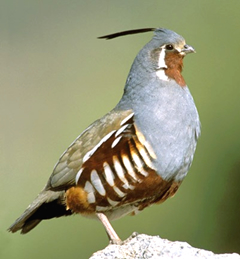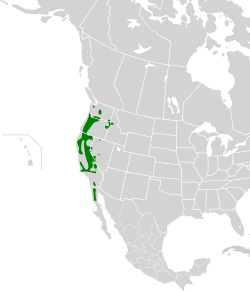This article has an unclear citation style .(March 2023) |
| Mountain quail | |
|---|---|
 | |
| Male | |
| Scientific classification | |
| Kingdom: | Animalia |
| Phylum: | Chordata |
| Class: | Aves |
| Order: | Galliformes |
| Family: | Odontophoridae |
| Genus: | Oreortyx Baird, 1858 |
| Species: | O. pictus |
| Binomial name | |
| Oreortyx pictus (Douglas, 1829) | |
 | |
The mountain quail (Oreortyx pictus) is a small ground-dwelling bird in the New World quail family. This species is the only one in the genus Oreortyx, which is sometimes included in Callipepla . This is not appropriate, however, as the mountain quail's ancestors diverged from other New World quails earlier than the bobwhites, no later than 6 mya. [2]








